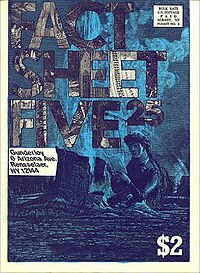
A fanzine is a non-professional and non-official publication produced by enthusiasts of a particular cultural phenomenon for the pleasure of others who share their interest. The term was coined in an October 1940 science fiction fanzine by Russ Chauvenet and first popularized within science fiction fandom, and from there the term was adopted by other communities.

A zine is a small-circulation self-published work of original or appropriated texts and images, usually reproduced via a copy machine. Zines are the product of either a single person or of a very small group, and are popularly photocopied into physical prints for circulation. A fanzine is a non-professional and non-official publication produced by enthusiasts of a particular cultural phenomenon for the pleasure of others who share their interest. The term was coined in an October 1940 science fiction fanzine by Russ Chauvenet and popularized within science fiction fandom, entering the Oxford English Dictionary in 1949.

A science-fiction fanzine is an amateur or semi-professional magazine published by members of science-fiction fandom, from the 1930s to the present day. They were one of the earliest forms of fanzine, within one of which the term "fanzine" was coined, and at one time constituted the primary type of science-fictional fannish activity ("fanac").

A punk zine is a zine related to the punk subculture and hardcore punk music genre. Often primitively or casually produced, they feature punk literature, such as social commentary, punk poetry, news, gossip, music reviews and articles about punk rock bands or regional punk scenes.
A minicomic is a creator-published comic book, often photocopied and stapled or with a handmade binding. In the United Kingdom and Europe the term small press comic is equivalent with minicomic, reserved for those publications measuring A6 or less.
Jack Melton Boardman, commonly known as John Boardman, is an American physicist. He is a former professor of physics at Brooklyn College; a noted science fiction fan, author and fanzine publisher; and a gaming authority.

Jonathan Allen Lethem is an American novelist, essayist, and short story writer. His first novel, Gun, with Occasional Music, a genre work that mixed elements of science fiction and detective fiction, was published in 1994. In 1999, Lethem published Motherless Brooklyn, a National Book Critics Circle Award-winning novel that achieved mainstream success. In 2003, he published The Fortress of Solitude, which became a New York Times Best Seller. In 2005, he received a MacArthur Fellowship. Since 2011, he has taught creative writing at Pomona College.
Aaron Elliott, better known as Aaron Cometbus, is an American musician, author, songwriter, roadie, and magazine editor, best known as the creator of the punk zine Cometbus.
Donna J. Kossy is a US writer, zine publisher, and online used book dealer based in Portland, Oregon. Specializing in the history of "forgotten, discredited and extreme ideas", which she calls "crackpotology and kookology", she is better known for her books Kooks: A Guide to the Outer Limits of Human Belief and Strange Creations: Aberrant Ideas of Human Origins from Ancient Astronauts to Aquatic Apes (2001). Kossy was also the founder and curator of the Kooks Museum, and the editor-publisher of the magazine Book Happy.
British small press comics, once known as stripzines, are comic books self-published by amateur cartoonists and comic book creators, usually in short print runs, in the UK. They're comparable to similar movements internationally, such as American minicomics and Japanese doujinshi. A "small press comic" is essentially a zine composed predominantly of comic strips. The term emerged in the early 1980s to distinguish them from zines about comics. Notable artists who have had their start in British small press comics include Eddie Campbell, Paul Grist, Rian Hughes, Jamie Hewlett, Alan Martin, Philip Bond and Andi Watson.
Boiled Angel was an early 1990s independent comic book created by Florida-based underground comic book artist Mike Diana. The comic contained graphic depictions of a variety of taboo and gory subject matters. It effectively became the first comic book in the United States to cause its creator to be convicted for artistic obscenity.
Trajectories was a 1980s tabloid magazine published in Austin, Texas by Richard Shannon and Susan Sneller. It featured news and articles on fantasy, science, science fantasy, science fiction, and science fiction philosophy. It contained reviews of books, poetry, short stories, music and performances. Articles and stories were contributed by Lewis Shiner2, John Shirley, Bruce Boston, Uncle River, Winter Damon and others. A total of six issues appeared irregularly over a six-year span.
Richard Shannon is a writer, performer, and speaker.

Janus was a feminist science fiction fanzine edited by Janice Bogstad and Jeanne Gomoll in Madison, Wisconsin, and closely associated with that city's science fiction convention, WisCon. It was repeatedly nominated for the Hugo Award for Best Fanzine ; this led to accusations that if Janus had not been feminist, it wouldn't have been nominated. Eighteen issues were published under this name from 1975 to 1980; it was succeeded by Aurora SF.
Argentus was a science fiction fanzine edited by Steven H Silver. It won the Chronic Rift Roundtable Award for Best Fanzine in 2009 and was nominated for the Hugo Award for Best Fanzine three times (2008–2010). The magazine ended publication in 2014.
Psycho Moto Zine is a periodical published from the late 1980s to the present day, consisting mostly of short stories, reviews, and artwork. This fanzine would be the birth of the Antagonist Art Movement, a consortium of like-minded artists, writers, filmmakers, etc.

Rocket's Blast Comicollector (RBCC) was a comics advertising fanzine published from 1964 to 1983. The result of a merger with a similar publication, RBCC's purpose was to bring fans together for the purpose of adding to their comic book collections. It also proved to be a launching pad for aspiring comic book creators, many of whom corresponded and exchanged their work through RBCC, and published work in the fanzine as amateurs.
Michelle Rau is an American cartoonist, writer, and artist known for publishing her cartoon zine, Lana's World. She was an active contributor in the alternative publishing, queer zine, and comics landscape of the 1980s and 1990s.
Capitol Crisis was a fanzine from the Washington, D.C. punk scene created by musician and disc jockey, Xyra Harper. The zine published five issues from November 1980 to May 1981 and was part of the foundation for D.C.'s emerging punk music scene. According to scholar Shayna Maskell, Harper and Capitol Crisis "worked to contest the dominant maleness of D.C. hardcore and its cultural production."






